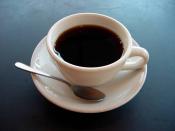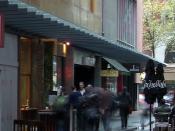As far back as 2700 B.C.. Chinese Emperor Shen Nung regularly imbibed hot brewed tea. Coffee was regarded by some Westerners as "the devil's brew" until the late sixteenth century, when Pope Clement VIII tasted it and gave it his blessing. Caffeine is the most popular drug in the world. Coffee consumption in the U.S. has actually been steadily declining since the l960s.
The main sources of caffeine are, coffee beans, tea leaves, cocoa pods and cola nuts. Another popular source is mate' leaves.
Pure caffeine is a bitter-tasting white powder that resembles cornstarch. Drip coffee contains more caffeine than percolated. Caffeine is a potent anpheteminelike stimulant. Caffeine is moderately soluble in water. Caffeine readily passes through cell membranes. After caffeine is ingested it is absorbed from the stomach and intestines into the bloodstream which then gets distributed to all the organs of the body. In the bloodstream caffeine travels to the liver, where it is converted into a number of breakdown products where it is excreted in the urine.
Many people like to start their day with coffee. It's probably not so much the taste rather is the jolt it gives them. Unfortunately, caffeine has undesirable effects. A mug of coffee can increase urination as much as 30 percent for up to three hours. Large fluid losses on a hot day can lead to dehydration. Increased stomach acid can aggravate ulcers or hightail hernia, and cause nausea, vomiting and diarrhea. Caffeine can cause an accelerated and irregular heartbeat. Where caffeine lifts your spirits, when it wears off there can be bouts of depression. If drank too close to bedtime, caffeine can disrupt your sleep. You can get the shakes from caffeine.
Recent studies have failed to find any relationship between caffeine and strokes or increased risk of heart attack.


